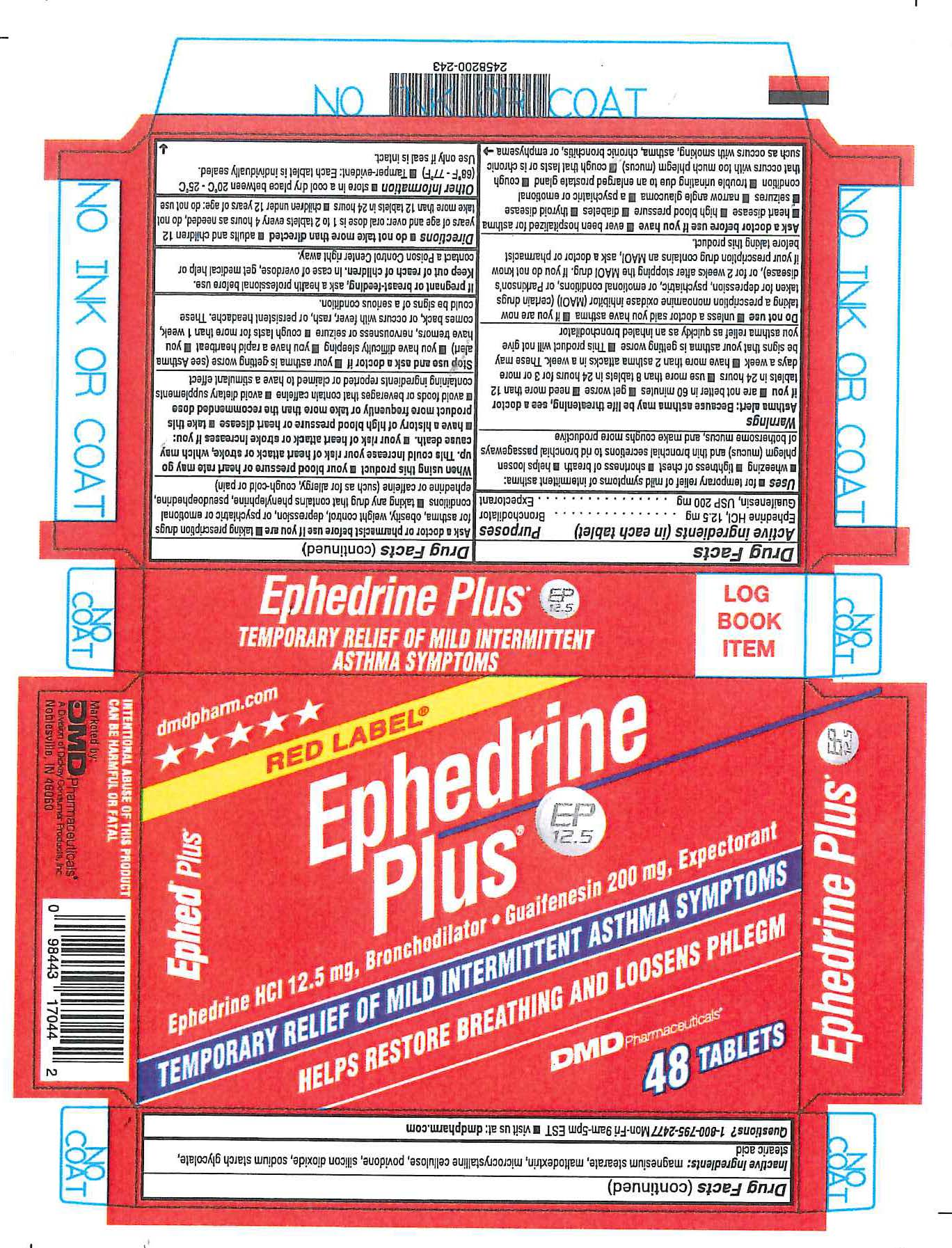Red Label Ephedrine Plus | Ephedrine Hydrochloride, Guaifenesin Tablet while Breastfeeding

What is Red Label Ephedrine Plus | Ephedrine Hydrochloride, Guaifenesin Tablet used for?
Brief: - Bronchodilator, Expectorant
Is using Red Label Ephedrine Plus | Ephedrine Hydrochloride, Guaifenesin Tablet safe or dangerous while breastfeeding?

Red Label Ephedrine Plus | Ephedrine Hydrochloride, Guaifenesin Tablet Breastfeeding Analsys
Ephedrine hydrochloride while Breastfeeding
Low RiskCAS Number: 299-42-3
An alkaloid derived from ephedra. It has sympathomimetic properties with direct and indirect effects on adrenergic receptors. Used parenterally to treat hypotension derived from spinal or epidural anesthesia due to its peripheral vasoconstrictor effects and improvement of heart tone. Used orally as a bronchodilator mixed in preparations for colds, bronchitis and asthma. Used illegaly as a psychostimulant and for weight loss, with serious health risks (van der Hoof 2002, Gruber 1998). See also information on Ephedra. Since the last update we have not found published data on its excretion in breast milk. Its large volume of distribution makes it unlikely it will pass into milk in significant amounts. After a cesarean section with epidural anesthesia and use of ephedrine there were no side effects in 100 newborns; the time of initial breastfeeding was not delayed with respect to newborns after cesareans under general anesthesia (Havas 2013). The use of ephedrine during delivery or cesarean section is not contraindicated with the early initiation of breastfeeding: as well as the unlikely excretion in breast milk there is a low amount of colostrum obtained by the newborn in the first hours of life. It may be desirable to minimize the continued use of oral preparations for colds/bronchitis which contain ephedrine since a case of crying, irritability and insomnia has been reported in a 3-month-old infant whose mother was taking a medication containing d-isoephedrine and dexbrompheniramine (Mortimer 1977). Simple preparations (a single active ingredient per drug) are preferable and even more so during breastfeeding. Abusive use as a psychostimulant or antiobesity product entails serious risks to the health of the mother and the infant and should be avoided (van der Hoof 2002, Gruber 1998). Topical use of ephedrine (see information on topical ephedrine) as a complement to preparations for local anesthetic, dermatologicals, stomatologicals or ophthalmologicals is compatible with breastfeeding (WHO 2002). See below the information of these related products:
Guaifenesin while Breastfeeding
Low RiskCAS Number: 93-14-1
It is used as an expectorant, alone or in association with other products. Proofs on its effectiveness are sparse. In some instances, preparations of Guaifenesin may contain alcohol as excipient with a concentration as high as 5%. At latest update, relevant published data on excretion into breast milk were not found. Until more information on this medication is available, other option known to be safer would be recommended, mostly in the post-natal period or in cases of prematurity. If used while breastfeeding, a moderate use with the lowest dose as possible and avoiding those preparations with alcoholic excipient, should be preferred. Because effectiveness is poor and likelihood of side effects does exist, especially in multi-association, the US Agency for Drug Administration (FDA) is currently doing efforts for discontinuation of this and others at-the-counter products, that are formulated for cough relief (Guaifenesin, Dextromethorphan, Phenylephrine, Pseudoephedrine, Brompheniramine, etc.)
Red Label Ephedrine Plus | Ephedrine Hydrochloride, Guaifenesin Tablet Breastfeeding Analsys - 2
Guaifenesin while Breastfeeding
CAS Number: 93-14-1
Neither the excretion of guaifenesin in milk nor its effect on breastfed infants have been studied. It is unlikely that with usual maternal doses amounts in breastmilk would harm the nursing infant, especially in infants over 2 months of age. It is best to avoid the use of products with a high alcohol content while nursing.
What should I do if already breastfed my kid after using Red Label Ephedrine Plus | Ephedrine Hydrochloride, Guaifenesin Tablet?
Red Label Ephedrine Plus | Ephedrine Hydrochloride, Guaifenesin Tablet is in the category of low risk, if you have already used it then its not a big deal if health and behavior of baby is good. However your health care provider shall be aware of the fact that you have used Red Label Ephedrine Plus | Ephedrine Hydrochloride, Guaifenesin Tablet so you should inform him based on your convenience.
My doctor has prescribed me Red Label Ephedrine Plus | Ephedrine Hydrochloride, Guaifenesin Tablet, what should I do?
Red Label Ephedrine Plus | Ephedrine Hydrochloride, Guaifenesin Tablet comes in category of low risk and if your doctor is aware that you are breastfeeding it should be ok to use
If I am using Red Label Ephedrine Plus | Ephedrine Hydrochloride, Guaifenesin Tablet, will my baby need extra monitoring?
Not much monitoring required while using Red Label Ephedrine Plus | Ephedrine Hydrochloride, Guaifenesin Tablet
Who can I talk to if I have questions about usage of Red Label Ephedrine Plus | Ephedrine Hydrochloride, Guaifenesin Tablet in breastfeeding?
US
National Womens Health and Breastfeeding Helpline: 800-994-9662 (TDD 888-220-5446) 9 a.m. and 6 p.m. ET, Monday through Friday
UK
National Breastfeeding Helpline: 0300-100-0212 9.30am to 9.30pm, daily
Association of Breastfeeding Mothers: 0300-330-5453
La Leche League: 0345-120-2918
The Breastfeeding Network supporter line in Bengali and Sylheti: 0300-456-2421
National Childbirth Trust (NCT): 0300-330-0700
Australia
National Breastfeeding Helpline: 1800-686-268 24 hours a day, 7 days a week
Canada
Telehealth Ontario for breastfeeding: 1-866-797-0000 24 hours a day, 7 days a week
